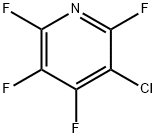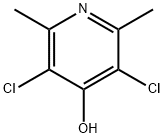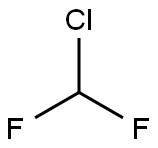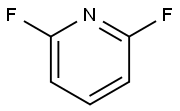3-Chloro-2,4,5,6-tetrafluoropyridine
- CAS NO.:1735-84-8
- Empirical Formula: C5ClF4N
- Molecular Weight: 185.51
- MDL number: MFCD00010624
- SAFETY DATA SHEET (SDS)
- Update Date: 2023-04-23 13:52:06

What is 3-Chloro-2,4,5,6-tetrafluoropyridine?
Chemical properties
CLEAR COLOURLESS LIQUID
General Description
3-Chloro-2,4,5,6-tetrafluoropyridine (3-chlorotetrafluoropyridine) is a fluoropyridine derivative. Its quantum mechanical calculations of energies, geometries and vibrational wave numbers have been performed by DFT level of theory. The interpretation of its FT-IR and FT-Raman spectra have been reported. It forms corresponding organo-zinc compound by reacting with zinc. 3-Chlorotetrafluoropyridine reacts with tris(diethylamino)phosphine (P(NEt)3) in the presence of a proton donor to form product with fluorine replaced by hydrogen at position 4.
Properties of 3-Chloro-2,4,5,6-tetrafluoropyridine
| Boiling point: | 118-121 °C (lit.) |
| Density | 1.609 g/mL at 25 °C (lit.) |
| refractive index | n |
| Flash point: | >230 °F |
| storage temp. | under inert gas (nitrogen or Argon) at 2-8°C |
| form | clear liquid |
| pka | -11.94±0.28(Predicted) |
| Specific Gravity | 1.641 |
| color | Colorless to Almost colorless |
| BRN | 475873 |
| CAS DataBase Reference | 1735-84-8(CAS DataBase Reference) |
| NIST Chemistry Reference | Pyridine, 3-chloro-2,4,5,6-tetrafluoro-(1735-84-8) |
Safety information for 3-Chloro-2,4,5,6-tetrafluoropyridine
| Signal word | Warning |
| Pictogram(s) |
 Corrosion Corrosives GHS05  Exclamation Mark Irritant GHS07 |
| GHS Hazard Statements |
H302:Acute toxicity,oral H312:Acute toxicity,dermal H314:Skin corrosion/irritation H315:Skin corrosion/irritation H318:Serious eye damage/eye irritation H319:Serious eye damage/eye irritation H332:Acute toxicity,inhalation H335:Specific target organ toxicity, single exposure;Respiratory tract irritation |
| Precautionary Statement Codes |
P261:Avoid breathing dust/fume/gas/mist/vapours/spray. P264:Wash hands thoroughly after handling. P264:Wash skin thouroughly after handling. P280:Wear protective gloves/protective clothing/eye protection/face protection. P310:Immediately call a POISON CENTER or doctor/physician. P303+P361+P353:IF ON SKIN (or hair): Remove/Take off Immediately all contaminated clothing. Rinse SKIN with water/shower. P305+P351+P338:IF IN EYES: Rinse cautiously with water for several minutes. Remove contact lenses, if present and easy to do. Continuerinsing. |
Computed Descriptors for 3-Chloro-2,4,5,6-tetrafluoropyridine
| InChIKey | UXUZMYHSICIOQT-UHFFFAOYSA-N |
New Products
4-Fluorophenylacetic acid 4-Methylphenylacetic acid N-Boc-D-alaninol N-BOC-D/L-ALANINOL Tert-butyl bis(2-chloroethyl)carbamate 3-Morpholino-1-(4-nitrophenyl)-5,6-dihydropyridin- 2(1H)-one Furan-2,5-Dicarboxylic Acid Tropic acid S-2-CHLORO PROPIONIC ACID ETHYL ISOCYANOACETATE 2-Bromo-1,3-Bis(Dimethylamino)Trimethinium Hexafluorophosphate (6-METHYL-[1,3]DITHIOLO[4,5-b]QUINOXALIN-2-ONE INDAZOLE-3-CARBOXYLIC ACID 4-IODO BENZOIC ACID (2-Hydroxyphenyl)acetonitrile 4-Bromopyrazole 5,6-Dimethoxyindanone 2-(Cyanocyclohexyl)acetic acid 4-methoxy-3,5-dinitropyridine 2-aminopropyl benzoate hydrochloride 1-(4-(aminomethyl)benzyl)urea hydrochloride diethyl 2-(2-((tertbutoxycarbonyl)amino) ethyl)malonate tert-butyl 4- (ureidomethyl)benzylcarbamate Ethyl-2-chloro((4-methoxyphenyl)hydrazono)acetateRelated products of tetrahydrofuran








You may like
-
 3-Chloro-2,4,5,6-tetrafluoropyridine CAS 1735-84-8View Details
3-Chloro-2,4,5,6-tetrafluoropyridine CAS 1735-84-8View Details
1735-84-8 -
 2033-24-1 98%View Details
2033-24-1 98%View Details
2033-24-1 -
 1975-50-4 98%View Details
1975-50-4 98%View Details
1975-50-4 -
 2-HYDROXY BENZYL ALCOHOL 98%View Details
2-HYDROXY BENZYL ALCOHOL 98%View Details
90-01-7 -
 2-Chloro-1,3-Bis(Dimethylamino)Trimethinium Hexafluorophosphate 221615-75-4 98%View Details
2-Chloro-1,3-Bis(Dimethylamino)Trimethinium Hexafluorophosphate 221615-75-4 98%View Details
221615-75-4 -
 61397-56-6 CIS BROMO BENZOATE 98%View Details
61397-56-6 CIS BROMO BENZOATE 98%View Details
61397-56-6 -
 14714-50-2 (2-Hydroxyphenyl)acetonitrile 98+View Details
14714-50-2 (2-Hydroxyphenyl)acetonitrile 98+View Details
14714-50-2 -
 118753-70-1 98+View Details
118753-70-1 98+View Details
118753-70-1
Statement: All products displayed on this website are only used for non medical purposes such as industrial applications or scientific research, and cannot be used for clinical diagnosis or treatment of humans or animals. They are not medicinal or edible.